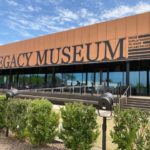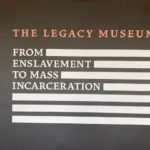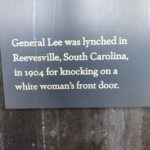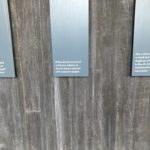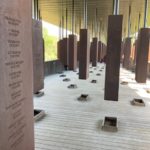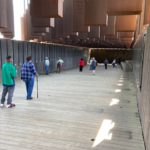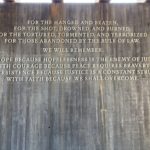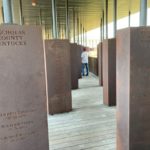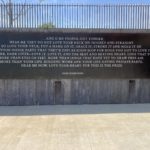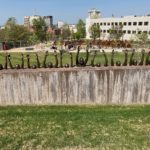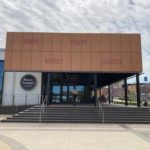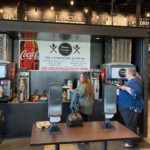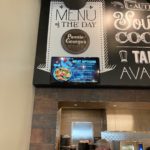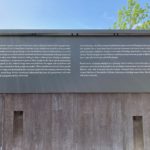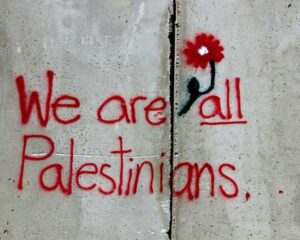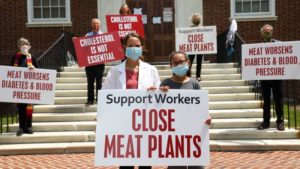The Legacy Museum: From Enslavement to Mass Incarceration in Montgomery, Alabama, is impressive, and is associated with The National Memorial for Peace and Justice, which is equally rousing, and less than a mile away.
I can’t share many photos of The Legacy Museum because taking pictures inside is not allowed, but let me just say that their artistry and use of technology is truly remarkable. Seriously. During one part of the visit, the holding cells that were used for slaves before an auction were recreated, and each cell has a hologram of a life sized person who is waiting to be sold into slavery. The hologram is triggered anytime a museum visitor stands in front of the cell, and the story of each cell’s inhabitant is then told by the hologram character in an absurdly personal way. I was floored.
From The Equal Justice Initiative (EJI) website: “The Legacy Museum: From Enslavement to Mass Incarceration is situated on a site in Montgomery where Black people were forced to labor in bondage. Blocks from one of the most prominent slave auction spaces in America, the Legacy Museum is steps away from the rail station where tens of thousands of Black people were trafficked during the 19th century…The Story: Slavery Evolved. To justify the brutal, dehumanizing institution of slavery in America, its advocates created a myth of racial difference. Stereotypes and false characterizations of Black people were created to defend their permanent enslavement as “most necessary to the well-being of the negro” – an act of kindness that reinforced white supremacy. The formal abolition of slavery did nothing to overcome the harmful ideas created to defend it, and so slavery did not end: it evolved. In the decades that followed, these beliefs in racial hierarchy took new expression in convict leasing, lynching, and other forms of racial terrorism that forced the exodus of millions of Black Americans to the North and West, where the myth of racial difference manifested in urban ghettos and generational poverty…EJI believes we need a new era of truth and justice that starts with confronting our history of racial injustice. American history begins with the creation of a myth to absolve white settlers of the genocide of Native Americans: the false belief that nonwhite people are less human than white people. This belief in racial hierarchy survived slavery’s abolition, fueled racial terror lynchings, demanded legally codified segregation, and spawned our mass incarceration crisis.”
“Went from the tree to the electric chair, from the electric chair to the gurney. They brought it inside and created another way of execution. They took off the white robe, and put on the Black robe. At the end of the journey, they still putting you to death.” – Anthony Ray Hinton (American activist and writer who spent 28 years on Alabama’s death row for a crime he did not commit).
The National Memorial for Peace and Justice is an extension of The Legacy Museum that bears witness and honors the lives of thousands of African Americans who were murdered by white mobs between 1877-1950. As per EJI, “More than 4,400 African American men, women, and children were hanged, burned alive, shot, drowned, and beaten to death by white mobs between 1877 and 1950. Millions more fled the South as refugees from racial terrorism, profoundly impacting the entire nation. Until now, there has been no national memorial acknowledging the victims of racial terror lynchings. On a six-acre site atop a rise overlooking Montgomery, the national lynching memorial is a sacred space for truth-telling and reflection about racial terror in America and its legacy.”
One of the many appalling stories describes how a man named General Lee was lynched for knocking on a white woman’s door: “On January 13, 1904, a mob of white people lynched a Black man known as General Lee in Reevesville, South Carolina, for allegedly knocking on the door of a white woman’s house. The night before, a white woman reported that she had opened the door to her home after hearing a knock and saw a Black man running away from her house. The next day, a group of white men from the town went to the local magistrate to seek a warrant for the arrest of Mr. Lee, whose foot they claimed could have made a track similar to the ones found outside the woman’s home. Authorities arrested Mr. Lee on the evening of January 13 and charged him with “criminally assaulting a white woman” for allegedly knocking on her door. One mile outside of Reevesville, a mob of 50 white men seized Mr. Lee from police officers who were transferring him by buggy to a local jail. The police officers who abandoned Mr. Lee reported hearing gun shots as they fled the scene. Two days later, Mr. Lee was found tied to a tree and shot to death. Newspapers reported that the woman who reported the alleged “crime” knew Mr. Lee and never claimed she believed he was the man at her home that night. No one was arrested in connection to the murder of General Lee. In a letter to the Governor of South Carolina, the local sheriff in Reevesville justified the mob’s actions by suggesting that Mr. Lee was in “bad-standing” with the local community and that people were surprised Mr. Lee “had not been dealt with in like manner several years ago”. During this era of racial terror, white allegations against Black people were rarely subject to scrutiny and often sparked violent reprisal even when, as here, there was no evidence tying the accused to any offense.”
“True peace is not merely the absence of tension. It is the presence of justice.” – Martin Luther King, Jr.
The Legacy Museum and The National Memorial are largely based on the tremendous work of Bryan Stevenson (an attorney who has represented many people on death row, and who is also the founder and executive director of The Equal Justice Initiative). I was lucky enough to read his excellent book “Just Mercy” about five years ago, which apparently inspired the idea for a museum. I knew that he was working with others on creating a museum, but I didn’t know that it was completed, or that I would be able to pay it a visit on my trip.
One of the main questions behind Mr. Stevenson’s work is how and why people are judged unfairly. Here are some key takeaways from the book “Just Mercy” that are explored further in both the museum and memorial:
“Capital punishment means them without the capital get the punishment.”
“The United States has the highest rate of incarceration in the world.”
One in three black male babies born this century is expected to be incarcerated.
We are the only country in the world that sentences children to life imprisonment without parole.
“Each of us is more than the worst thing we’ve ever done.”
“The opposite of poverty is not wealth; the opposite of poverty is justice.”
“The true measure of our character is how we treat the poor, the disfavored, the accused, the incarcerated, and the condemned.”
“The return of white supremacy and racial subordination came quickly after federal troops left Alabama in the 1870s.”
“Black men are eight times more likely to be killed by police than whites.”
Anthony Ray Hinton’s words, “went from the tree to the electric chair, from the electric chair to the gurney”, really resonated with me. Even though we like to think that we have made progress, non-White people are still being killed (and incarcerated) at higher rates than Whites too. In fact, even though the numbers have improved, White people still live about 3.6 years longer than Black people in the US (which is a 50% reduction from 1970). There are many factors involved, including both diets and racist healthcare practices. According to Historians Ibram X. Kendi and Keisha Blain, “This has been in the making for decades. Even though this is a new virus (COVID-19),…it connects to a larger history of racial inequality”. Kendi is a cancer survivor and notes Black and Latinx are more at risk from preexisting conditions because of a history of racist policies. According to The American Cancer Society, “Black people have the highest death rate and shortest survival of any racial/ethnic group in the United States for most cancers. For example, Black women are 41% more likely to die from breast cancer than White women, despite lower incidence of the disease.” Why is that? We know that the biggest contributing factor to chronic illness is diet. Is it just a coincidence that a disproportionate number of Black, Brown and Native American populations live in food-apartheid areas (often polluted neighborhoods), where it is nearly impossible to access healthy, affordable (disease preventing & reversing) plant-based foods?
One of the few glaring omissions in The Legacy Museum is the mention of heroes like John Brown who gave up their lives to free the slaves. After inquiring, I mentioned to a few of the museum employees that it would be nice, and even inspiring, if the museum could provide some of the names of the small percentage of non-Black people who pushed back and risked their lives in an attempt to end slavery, and fight the good fight as well.
“If you want to know where you would have stood on slavery before the Civil War, don’t look at where you stand on slavery today. Look at where you stand on animal rights.” – Paul Watson (activist & founder of Sea Shepherd Conservation Society)
The other striking oversight was having a Pannie-George’s Kitchen restaurant on the premises. Wow. Pannie-George’s Kitchen pretty much serves up misery and premature death on a daily basis in the form of fried chicken, beef ribs, macaroni cheese, and other heinous dishes as well. Justice & Equality? Really? I was surprised that The Legacy Museum creators, who do a wonderful job and have an amazing talent for detail, could also be so recklessly insensitive when choosing a restaurant partner. Whether it is ignorance, willful blindness, cognitive dissonance, Carnism, or something else, clearly, The Legacy Museum is being hypocritical and not connecting the dots. The Standard American Diet (SAD) is the leading cause of death in the US, and guess what, a disproportionate number of non-white people are dying because of the very foods that Pannie-George’s Kitchen sells. In addition, 75 billion animals are imprisoned, and live lives of unimaginable suffering before they’re slaughtered each year to accommodate this same wretched and broken food system. And if that wasn’t enough, the most destructive industry facing our planet today is animal agriculture. Mic drop? Hopefully, The Legacy Museum will protect its reputation, and step up and do the right thing soon. Our current food system is perhaps the biggest social justice issue of our lifetime, and so far, The Legacy Museum is completely dropping the ball.
Knowing that our food system is also based on violence, abuse, and traumatic death, when and where does it all end?
My visit to both The Legacy Museum and The National Memorial was one of the most powerful and moving “institutional” experiences that I have ever had. It rivals the discarded shoes of Holocaust victims exhibit at the Yad Vashem Holocaust Museum in Jerusalem (where five or six of us stared at each other and cried openly), and the Dachau Concentration Camp Memorial site in Germany.
The Bottom Line on The Legacy Museum: From Enslavement to Mass Incarceration & The National Memorial for Peace and Justice? Excellent, and Highly Recommended!
Click here for the Legacy Museum: From Enslavement to Mass Incarceration, and the National Memorial for Peace and Justice.
Click here for the Equal Justice Initiative website.
Click hear to learn more from the EJI “Lynching in America” website.
Click here for information on Bryan Stevenson’s book “Just Mercy”.
Click here to learn more about the health disparities between Blacks, Hispanics, Native Americans, and Whites.
Click here to learn more about the Black-White life expectancy gap.
Click here to learn more about African American cancer rates.
Click here to learn more about racial inequality, and food apartheid areas.
Click here for more information on the Dachau Concentration Camp Memorial.
Click here for more information on the Yad Vashem Holocaust Museum.


